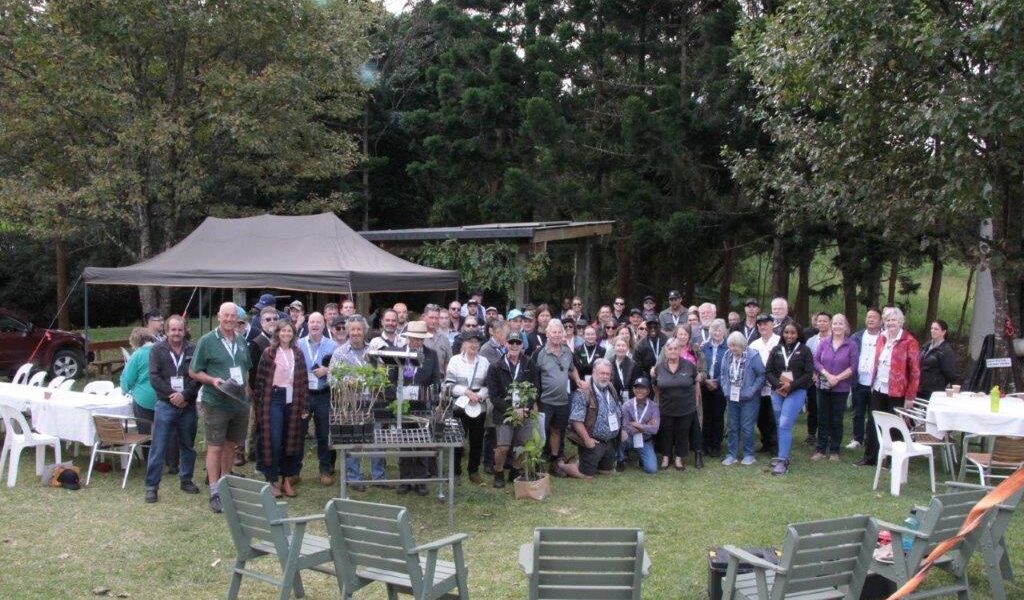Propagators enjoy a breath of fresh air
By Karen Smith
For the 52nd year, propagators from Australia and overseas came together to ‘Seek and Share’ knowledge of propagation in all its forms. I congratulate the organisers of the International Plant Propagators (IPPS) Conference, “A Breath of Fresh Air,’ held in Ballina NSW for presenting an excellent venue and a most informative program. Special thanks to convenor Ray Parker and his team.
As well as the steady hand of years of growing and propagating experience, there was an abundance of youthful enthusiasm showing much promise for the future health of our industry.
Garden City Plastics should be heartily thanked for their continued support of the ‘Six Pack’. Attendees at IPPS conferences from 2003 will be familiar with the Six Pack concept. Young horticulturists provide support logistics at the conference in return for uniform, accommodation, and conference extras. IPPS provides opportunities for these young horticulturists to expand their network and learn from a wide range of experts from all over Australia. IPPS Australia also participates in an exchange program with IPPS Southern Africa. This year Nosipho Ndlovu represented Southern Africa, and Josh Taylor represented IPPS Australia in Southern Africa, and both recounted their experiences and impressions gained during their exchanges at the Ballina conference.
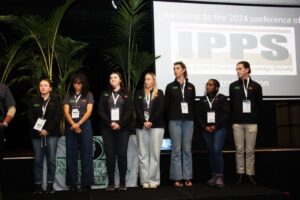
Zoe Williams, in discussion with industry stalwart Jane Edmonson, recounted her experiences after receiving a Global Footprints Scholarship in 2022. Zoe is a shining example of why young horticulturists should be actively encouraged to apply for industry programs such as the Six Pack and scholarships such as Global Footprints. These opportunities will open up new horizons for both the horticulturist and their employer, who ever that may be.
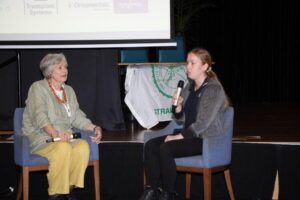
As winner of the Rod Tallis Award, Lisa Wightwick, also a previous Six Pack-er, presented her paper on improvements in tissue culture. Lisa credited her interest and enthusiasm for sharing knowledge to the IPPS motto of ‘Seek and Share.’ The award is named after one of the Society’s most respected members and recognises outstanding achievement by the younger section of our industry.
Samantha Birkwood, now owner of Bamboo World at Tuckombil, described her unconventional pathway into horticulture that started with the military and continued with corporate roles in Asia and Europe. There was an underlying message that young people should take opportunities as they come and develop best practice from experience gained.
Plant propagation is a dynamic industry, and the changing environment presents new challenges every season. There is an ongoing quest for better performing plants suited to novel applications such as degraded environments, green walls or indoor biophilic designs, not to mention the ‘next good thing’ that could become the popular trend in the market.
Plant breeders and propagators such as Angus Stewart, Des Boorman, Mark Dunphy, Clive Larkman, Jayeni Hiti-Bandaralage, Ranjith Pathirana, and Josekutty Puthyaparambil shared their experience, failures and successes at the conference. It is this wealth of experience that is most beneficial to horticulturists young and old. Des Boorman particularly shared not only his interest in Brachychiton breeding and propagation, but his substantial skill in grafting.
Much of the east coast was covered in rainforest and the area between Ballina, Byron Bay and Lismore was once the largest area of lowland tropical forest in Australia. Today only 1% of this forest remains. Mark Dunphy provided some insight into the reforestation of this area. He described the unintentional ignorance of early seed collectors facilitating inbreeding of the native trees by constantly collecting seed from the same areas. He explained that now, by collecting seed from a wider range of the east coast from North Queensland to Southern NSW, they can expand the genetic range and improve the quality of the ‘Big Scrub’ in the hinterland of Byron Bay.
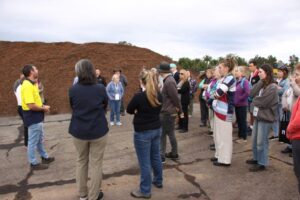
Plant use in the environment was another facet of the conference. John Daly outlined how people’s connection to nature or biophilia can improve performance and wellbeing. In an interesting section of his presentation, John cited a trial at a Queensland school that assessed the effect of plants in the classroom. In collaboration with Prof Margaret Burchett, they found a measurable improvement in student performance.
Mark Thomson provided an architectural insight into achieving better air quality and ambience in the built environment. Mark cited examples of how designs incorporating greenlife can be misunderstood, and benefits reduced by inappropriate building use and renovation. He explained how an office used green life to reduce volatile organic compounds (VOC) released by furniture and floor coverings, only to have the VOC’s reintroduced by inappropriate storage of printing material and brochures. He also provided an example of a renovation removing green life and installing more energy intensive air conditioning.
Building a nursery from scratch? David Hancock from Natural Area Nursery described how to do it. David, no stranger to IPPS, detailed the new nursery he and his team built after a forced relocation. Sabine Suess is the plant yield coordinator at Natural Area and she described what a plant yield coordinator does. Anticipating problems such as insects, disease and weeds before they become major problems is the key, as well as detecting and controlling pest animals. Managing nursery infrastructure and watering is an essential part of maximising yield. Communication with the team and documentation maximises the benefits of targeted nursery control.
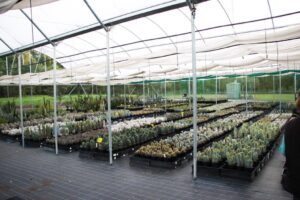
Clive Larkman uses the example of a customer who wanted two tonnes of lavender oil, when local suppliers only produce 100 kg per year, to promote a larger local lavender industry. Similarly, Jayeni Hiti-Bandaralage provided the ‘good oil’ on her efforts to create a supply of Red Bayberry (Myrica rubra) using tissue culture methods. Both plants are not found naturally in the southern hemisphere and a supply from Australia could supply markets in China and North America out of season.
The support industry for nurseries was represented not only by the sponsors of the event but by presentations by industry specialists. Gary Murdock-Brown focused on efficient nursery water use and diagnosing problems associated with blockages. Blockages restrict flow and increase the load on pumps, increasing energy use. Scale and biofilms are the main culprits. Lack of labour is always a restriction in nurseries. Vision-based robotics and nursery automation have increased production in some nurseries and are likely to be more widely used in future. Daniel Parsons and Luke Weisenberger outlined considerations for nursery owners preparing for automation.
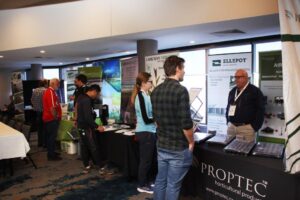
No industry can be successful without qualified staff. The ‘one-size-fits-all’ approach to education and training is no longer best practice according to Robert Davies from Wollongbar TAFE. Recognised qualifications are achievable by a variety of methods. Classroom-based ‘face to face,’ accredited short courses, ‘digital online’ delivery and workshops, or blended delivery combining all of the above with workplace assessment can lead to a recognised qualification in horticulture.
Being close to the Queensland border, red imported fire ants are affecting the free flow of nursery products. John McDonald from Greenlife Industry Australia presented the latest information about the control of this imported pest that had had a significant impact on southeastern Queensland. John suggested despite the nursery industry being blamed for distribution and being unfairly targeted, the actual culprit is the movement of soil and fill used mainly for new housing developments and roads.
Hospitality during the nursery tours was also first class. I look forward to these visits. Go Grow Services, a growing media producer, gave us an insight into media production and how the business was affected by fires and floods. Contamination by unwanted materials such as building waste and asbestos is of concern.

How do you tell the difference between running and clumping bamboo? Ask the helpful staff at Bamboo World. Picnic lunch at Parkers Place was in an idyllic location set among gardens and shade trees. The tour group also visited Alstonville plants, with their extensive collection of Hoya plants and more, as well as Pearce’s Nursery that housed an impressive selection of cacti and succulents among other things.
The gala dinner was held on Friday evening. As always it was a lot of fun as it not only includes award presentations but is also the night of the auctions.
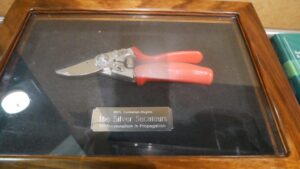
Thanks to the successful bidders as they were very generous. Proceeds of the auction help fund the Southern African exchange program. Josh Waterworth was the successful bidder for the ‘Silver Secateurs.’ The silver secateurs are held by the successful bidder for a year and are returned each year to the conference, and re-offered at the following conference. I do not know how much money these secateurs have raised over the years but it is a worthy cause. Thanks also to the auctioneer Clive Larkman and his Six Pack assistants.
The award winners were:
Steve Vallance Pewter Tankard Award – Dermot Molloy
Edward & Mary Bunker Award – Karen Smith
Rod Tallis Memorial Youth Award – Lisa Wightwick
Award of Honour – David Hancock
Honorary Life Membership – Michael Gleeson
Anita Boucher Award – Lisa Wightwick
All images supplied by Karen Smith

